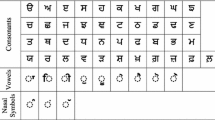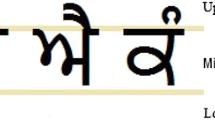Abstract
This paper presents a language-based efficient post-processing algorithm for the recognition of online unconstrained handwritten Gurmukhi characters. A total of 93 stroke classes have been identified to recognize the Gurmukhi character set in this work. Support Vector Machine (SVM) classifier has been employed for stroke classification. The main objective of this paper is to improve the character level recognition accuracy using an efficient Finite State Automata (FSA)-based formation of Gurmukhi characters algorithm. A database of 21,945 online handwritten Gurmukhi words is primarily collected in this experiment. After analysing the collected database, we have observed that a character can be written using one or more strokes. Therefore, a total of 65,946 strokes have been annotated using the 93 identified stroke classes. Among these strokes, 15,069 stroke samples are considered for training the classifier. The proposed system achieved promising recognition accuracy of 97.3% for Gurmukhi characters, when tested with a new database of 8,200 characters, written by 20 different writers.














Similar content being viewed by others
References
Liu C L, Jaeger S and Nakagawa M 2004 Online recognition of Chinese characters: the state-of-the-art. IEEE Trans. Pattern Anal. Mach. Intell. 26(2): 198–213
Jäger S, Liu C L and Nakagawa M 2003 The state of the art in Japanese online handwriting recognition compared to techniques in western handwriting recognition. Docum. Anal. Recognit. 6(2): 75–88
Jung K C, Yoon S M and Kim H J 2000 Continuous HMM applied to quantization of on-line Korean character spaces. J. Pattern Recognit. Lett.. 21(4): 303-310
Sternby J, Morwing J, Andersson J and Friberg C 2009 On-line Arabic handwriting recognition with templates. J. Pattern Recognit. 42(12): 3278–3286
Bhattacharya N and Pal U 2012 Stroke segmentation and recognition from Bangla online handwritten text. In: Proceedings of the International Conference on Frontiers in Handwriting Recognition (ICFHR), pp. 740–745
Bharath A and Madhvanath S 2012 HMM-based lexicon-driven and lexicon-free word recognition for online handwritten Indic scripts. IEEE Trans. Pattern Anal. Mach. Intell. 34(4): 670–682
Biswas C, Bhattacharya U and Parui S K 2012 HMM based online handwritten Bangla character recognition using Dirichlet distributions. In: Proceedings of the International Conference on Frontiers in Handwriting Recognition (ICFHR), pp. 600–605
Sundaram S and Ramakrishan A G 2011 Lexicon-free, novel segmentation of online handwritten Indic words. In: Proceedings of the International Conference on Document Analysis and Recognition, pp. 1175–1179
Prasad M M, Sukumar M and Ramakrishnan A G 2009 Divide and conquer technique in online handwritten Kannada character recognition. In: Proceedings of the International Workshop on Multilingual OCR, p. 11
Kumar R and Sharma R K 2013 An efficient post processing algorithm for online handwriting Gurmukhi character recognition using set theory. Int. J. Pattern Recognit. Artif. Intell. 27(04): 1353002(1–16)
Kumar R, Sharma R K and Sharma A 2015 Recognition of multi-stroke based online handwritten Gurmukhi aksharas. In: Proc. Natl. Acad. Sci. India Sect. A Phys. Sci. 85(1): 159–168
Verma K and Sharma R K 2017 Comparison of HMM-and SVM-based stroke classifiers for Gurmukhi script. Neural Comput. Appl. 28(1): 51–63
Tappert C C, Suen C Y and Wakahara T 1990 The state of the art in online handwriting recognition. IEEE Trans. Pattern Anal. Mach. Intell. 12(8): 787–808
Gao J, Zhu B and Nakagawa M 2014 Building compact recognizer with recognition rate maintained for on-line handwritten Japanese text recognition. J. Pattern Recognit. Lett. 35: 169-177
Aparna K H, Subramanian V, Kasirajan M, Prakash G V, Chakravarthy V S and Madhvanath S 2004 Online handwriting recognition for Tamil. In: Proceedings of the 9th International Workshop on Frontiers in Handwriting Recognition, pp. 438–443
Swethalakshmi H, Jayaraman A, Chakravarthy V S and Sekhar C C 2006 Online handwritten character recognition of Devanagari and Telugu Characters using support vector machines. In: Proceedings of the 10th International Workshop on Frontiers in Handwriting Recognition, Suvisoft
Rampalli R and Ramakrishnan A G 2011 Fusion of complementary online and offline strategies for recognition of handwritten Kannada characters. J. Univers. Comput. Sci. 17(1): 81–93
Roy K, Bandhopadhyay A and Mondal R 2012 Stroke-database design for online handwriting recognition in Bangla. Int. J. Mod. Eng. Res. 2(4): 2534–2540
Samanta O, Bhattacharya U and Parui S K 2014 Smoothing of HMM parameters for efficient recognition of online handwriting. J. Pattern Recognit. 47(11): 3614–3629
Sharma A, Kumar R and Sharma R K 2008 Online handwritten Gurmukhi character recognition using elastic matching. In: Proceedings of the IEEE Congress on Image and Signal Processing, Hainan, China, pp. 391–396
Sharma A, Kumar R and Sharma R K 2009 Rearrangement of recognized strokes in online handwritten Gurmukhi words recognition. In: Proceedings of the 10th International Conference on Document Analysis and Recognition, Barcelona, Spain, pp. 1241–1245
Sharma A, Kumar R and Sharma R K 2010 HMM-based online handwritten Gurmukhi character recognition. Int. J. Mach. Graph. Vis. 19(4): 439–449
Singh G and Sachan M 2015 A framework of online handwritten Gurmukhi script recognition. Int. J. Comput. Sci. Technol. 6: 52–56
Verma K and Sharma R K 2015 Performance analysis of zone based features for online handwritten Gurmukhi script recognition using Support Vector Machine. In: Progress in Systems Engineering, Springer, pp. 747–753
Bahri H 1982 Teach yourself Panjabi. Patiala: Publication Bureau, Panjabi University
Chen J W and Lee S Y 1996 On-line handwriting recognition of Chinese characters via a rule-based approach. In: Proceedings of the 13th International Conference on Pattern Recognition, vol. 3, pp. 220–224
Jayaraman A, Sekhar C C and Chakravarthy V S 2007 Modular approach to recognition of strokes in Telugu script. In: Proceedings of the 9th International Conference on Document Analysis and Recognition, vol. 1, pp. 501–505
Sharma A, Sharma R K and Kumar R 2009 Online handwritten Gurmukhi character recognition. PhD Thesis, Thapar University, Patiala, India
Chang C C and Lin C J 2011 LIBSVM: a library for support vector machines. ACM Trans. Intell. Syst. Technol. 2(3): 27
Acknowledgements
We take this opportunity to extend our special thanks to Technology Development for Indian Languages (TDIL), DeitY, MoCIT and Government of India for sponsoring this research work.
Author information
Authors and Affiliations
Corresponding author
Rights and permissions
About this article
Cite this article
SINGH, H., SHARMA, R.K. & SINGH, V.P. Recognition of online unconstrained handwritten Gurmukhi characters based on Finite State Automata. Sādhanā 43, 192 (2018). https://doi.org/10.1007/s12046-018-0961-4
Received:
Revised:
Accepted:
Published:
DOI: https://doi.org/10.1007/s12046-018-0961-4




